reset MERCEDES-BENZ CLS 2010 Owners Manual
[x] Cancel search | Manufacturer: MERCEDES-BENZ, Model Year: 2010, Model line: CLS, Model: MERCEDES-BENZ CLS 2010Pages: 308, PDF Size: 5.71 MB
Page 8 of 308
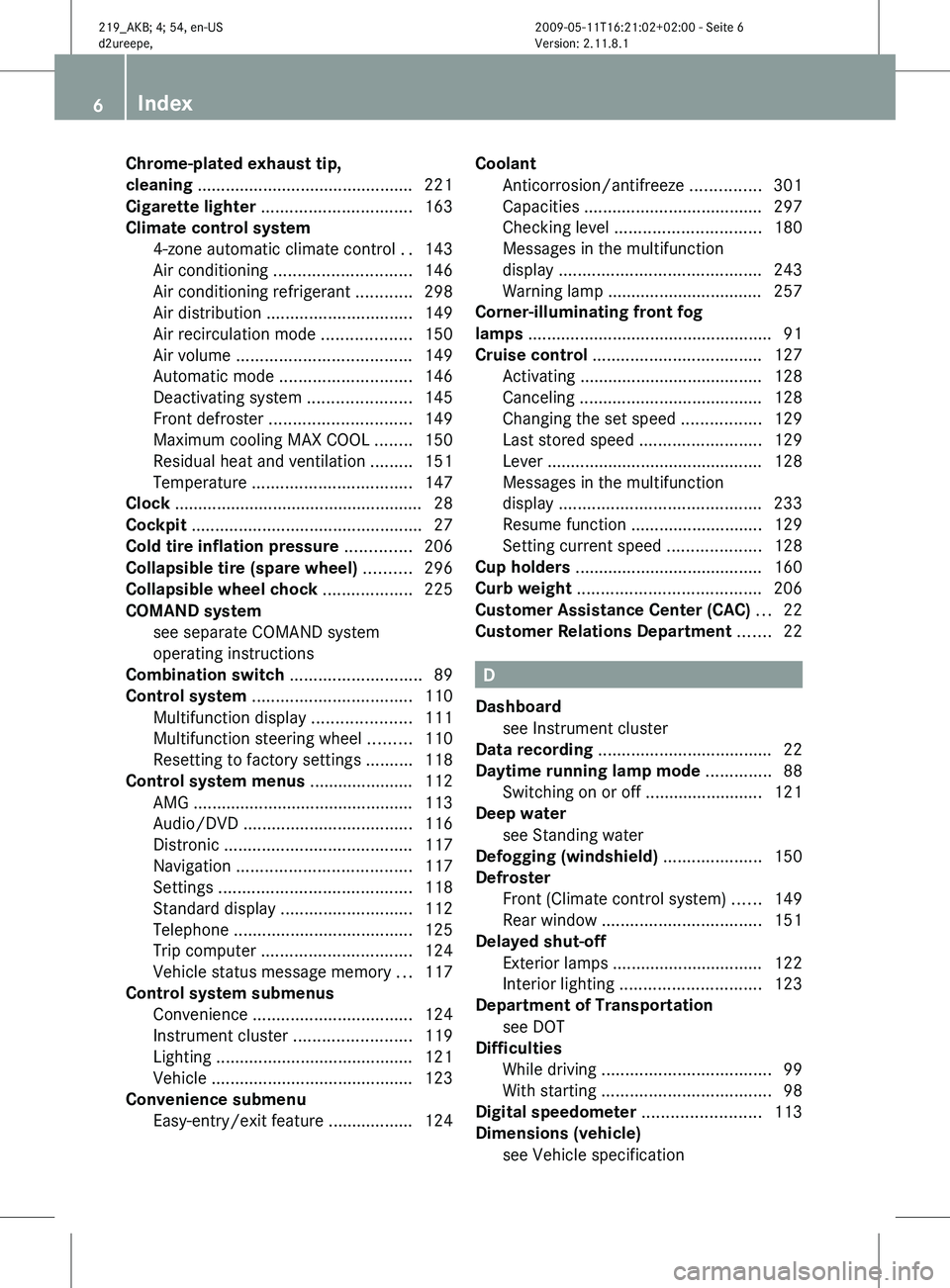
Chrome-plated exhaust tip,
cleaning
.............................................. 221
Cigarette lighter ................................ 163
Climate control system
4-zone automatic climate control
.. 143
Air conditioning ............................. 146
Air conditioning refrigerant ............ 298
Air distribution ............................... 149
Air recirculation mode ................... 150
Air volume ..................................... 149
Automatic mode ............................ 146
Deactivating system ......................145
Front defroster .............................. 149
Maximum cooling MAX COOL ........150
Residual heat and ventilation ......... 151
Temperature .................................. 147
Clock ..................................................... 28
Cockpit ................................................. 27
Cold tire inflation pressure ..............206
Collapsible tire (spare wheel) ..........296
Collapsible wheel chock ...................225
COMAND system see separate COMAND system
operating instructions
Combination switch ............................89
Control system .................................. 110
Multifunction display .....................111
Multifunction steering wheel ......... 110
Resetting to factory settings .......... 118
Control system menus ...................... 112
AMG ............................................... 113
Audio/DVD .................................... 116
Distronic ........................................ 117
Navigation ..................................... 117
Settings ......................................... 118
Standard display ............................ 112
Telephone ...................................... 125
Trip computer ................................ 124
Vehicle status message memory ...117
Control system submenus
Convenience .................................. 124
Instrument cluster .........................119
Lighting .......................................... 121
Vehicle ........................................... 123
Convenience submenu
Easy-entry/exit feature .................. 124 Coolant
Anticorrosion/antifreeze ...............301
Capacities ...................................... 297
Checking level ............................... 180
Messages in the multifunction
display ........................................... 243
Warning lamp ................................. 257
Corner-illuminating front fog
lamps .................................................... 91
Cruise control .................................... 127
Activating ....................................... 128
Canceling ....................................... 128
Changing the set speed .................129
Last stored speed .......................... 129
Lever .............................................. 128
Messages in the multifunction
display ........................................... 233
Resume function ............................ 129
Setting current speed .................... 128
Cup holders ........................................ 160
Curb weight ....................................... 206
Customer Assistance Center (CAC) ...22
Customer Relations Department .......22 D
Dashboard see Instrument cluster
Data recording ..................................... 22
Daytime running lamp mode ..............88
Switching on or off ......................... 121
Deep water
see Standing water
Defogging (windshield) .....................150
Defroster Front (Climate control system) ......149
Rear window .................................. 151
Delayed shut-off
Exterior lamps ................................ 122
Interior lighting .............................. 123
Department of Transportation
see DOT
Difficulties
While driving .................................... 99
With starting .................................... 98
Digital speedometer .........................113
Dimensions (vehicle) see Vehicle specification 6
Index 219_AKB; 4; 54, en-US
d2ureepe,
Version: 2.11.8.1 2009-05-11T16:21:02+02:00 - Seite 6
Page 14 of 308
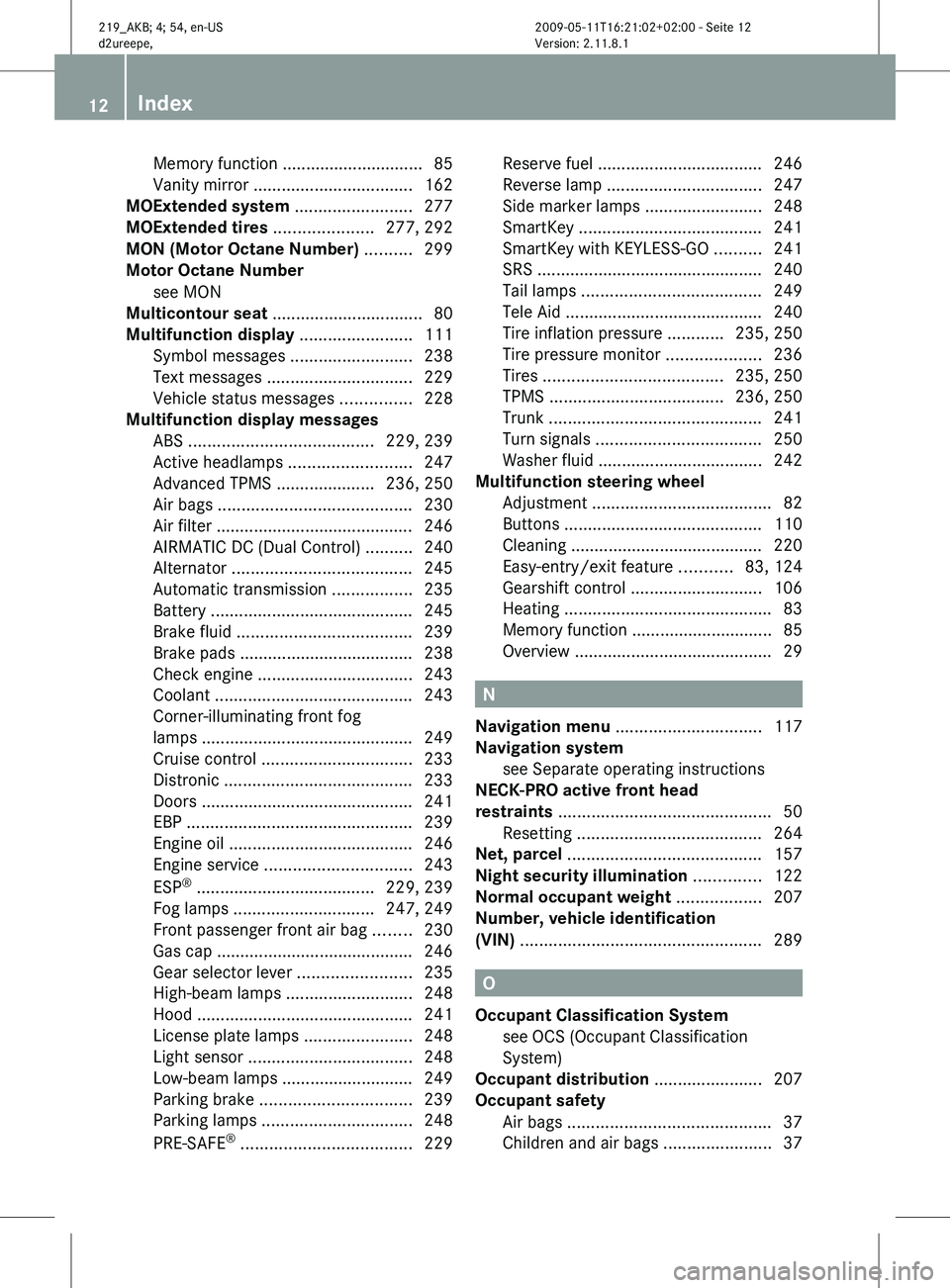
Memory function .............................. 85
Vanity mirror ..................................
162
MOExtended system ......................... 277
MOExtended tires ..................... 277, 292
MON (Motor Octane Number) ..........299
Motor Octane Number see MON
Multicontour seat ................................ 80
Multifunction display ........................ 111
Symbol messages .......................... 238
Text messages ............................... 229
Vehicle status messages ............... 228
Multifunction display messages
ABS ....................................... 229, 239
Active headlamps .......................... 247
Advanced TPMS ..................... 236, 250
Air bags ......................................... 230
Air filter .......................................... 246
AIRMATIC DC (Dual Control) .......... 240
Alternator ...................................... 245
Automatic transmission ................. 235
Battery ........................................... 245
Brake fluid ..................................... 239
Brake pads ..................................... 238
Check engine ................................. 243
Coolant .......................................... 243
Corner-illuminating front fog
lamps ............................................. 249
Cruise control ................................ 233
Distronic ........................................ 233
Doors ............................................. 241
EBP ................................................ 239
Engine oil ....................................... 246
Engine service ............................... 243
ESP ®
...................................... 229, 239
Fog lamps .............................. 247, 249
Front passenger front air bag ........230
Gas cap .......................................... 246
Gear selector lever ........................235
High-beam lamps ........................... 248
Hood .............................................. 241
License plate lamps ....................... 248
Light sensor ................................... 248
Low-beam lamps ............................ 249
Parking brake ................................ 239
Parking lamps ................................ 248
PRE-SAFE ®
.................................... 229Reserve fuel ...................................
246
Reverse lamp ................................. 247
Side marker lamps .........................248
SmartKey ....................................... 241
SmartKey with KEYLESS-GO ..........241
SRS ................................................ 240
Tail lamps ...................................... 249
Tele Aid .......................................... 240
Tire inflation pressure ............235, 250
Tire pressure monitor .................... 236
Tires ...................................... 235, 250
TPMS ..................................... 236, 250
Trunk ............................................. 241
Turn signals ................................... 250
Washer fluid ................................... 242
Multifunction steering wheel
Adjustment ...................................... 82
Buttons .......................................... 110
Cleaning ......................................... 220
Easy-entry/exit feature ...........83, 124
Gearshift control ............................ 106
Heating ............................................ 83
Memory function .............................. 85
Overview .......................................... 29 N
Navigation menu ............................... 117
Navigation system see Separate operating instructions
NECK-PRO active front head
restraints ............................................. 50
Resetting ....................................... 264
Net, parcel ......................................... 157
Night security illumination .............. 122
Normal occupant weight .................. 207
Number, vehicle identification
(VIN) ................................................... 289 O
Occupant Classification System see
OCS (Occupant Classification
System)
Occupant distribution ....................... 207
Occupant safety Air bags ........................................... 37
Children and air bags ....................... 3712
Index 219_AKB; 4; 54, en-US
d2ureepe,
Version: 2.11.8.1 2009-05-11T16:21:02+02:00 - Seite 12
Page 16 of 308
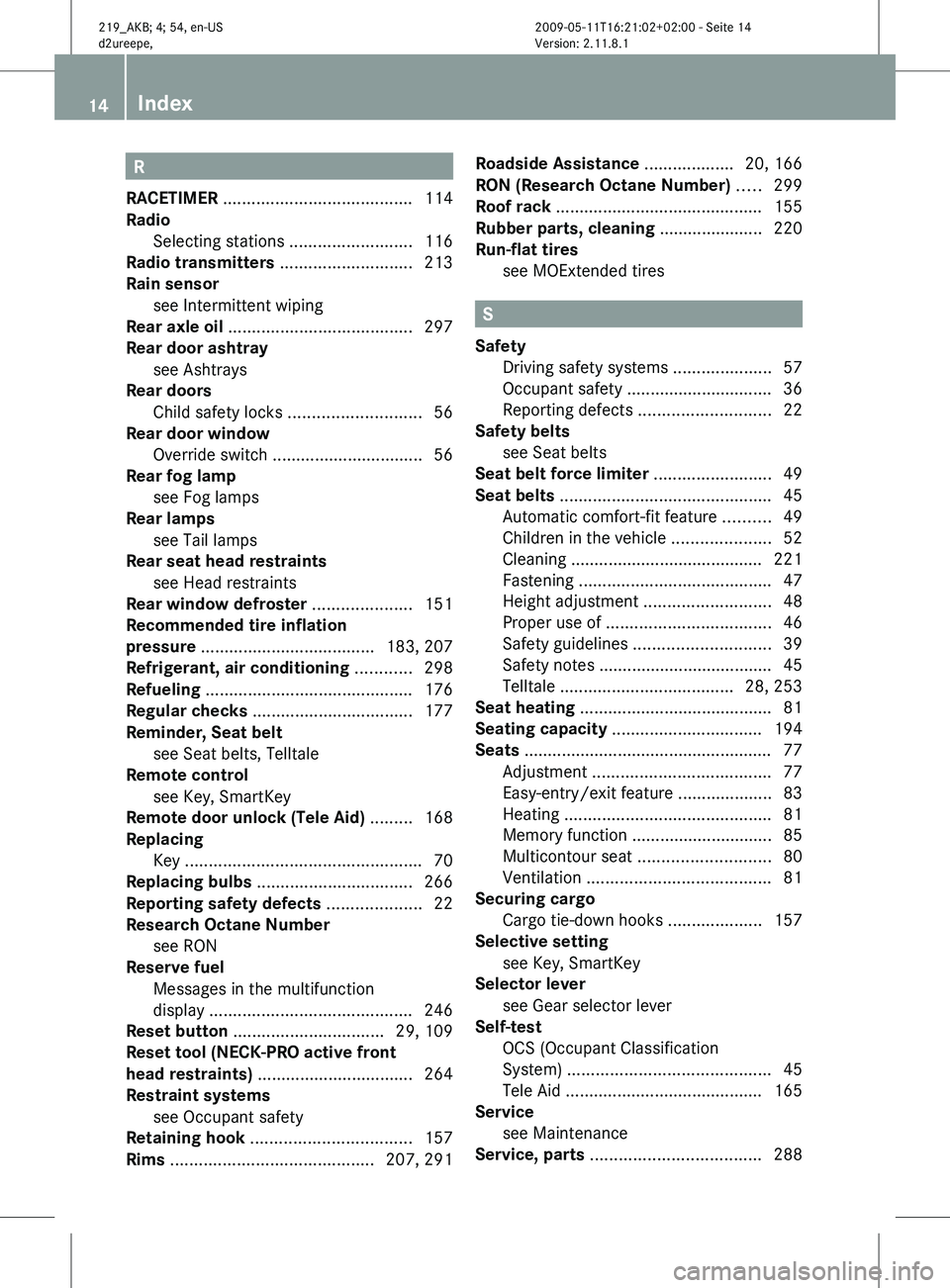
R
RACETIMER ........................................ 114
Radio Selecting stations
..........................116
Radio transmitters ............................213
Rain sensor see Intermittent wiping
Rear axle oil ....................................... 297
Rear door ashtray see Ashtrays
Rear doors
Child safety locks ............................ 56
Rear door window
Override switch ................................ 56
Rear fog lamp
see Fog lamps
Rear lamps
see Tail lamps
Rear seat head restraints
see Head restraints
Rear window defroster ..................... 151
Recommended tire inflation
pressure ..................................... 183, 207
Refrigerant, air conditioning ............ 298
Refueling ............................................ 176
Regular checks .................................. 177
Reminder, Seat belt see Seat belts, Telltale
Remote control
see Key, SmartKey
Remote door unlock (Tele Aid) .........168
Replacing
Key .................................................. 70
Replacing bulbs ................................. 266
Reporting safety defects .................... 22
Research Octane Number see RON
Reserve fuel
Messages in the multifunction
display ........................................... 246
Reset button ................................ 29, 109
Reset tool (NECK-PRO active front
head restraints) ................................. 264
Restraint systems see Occupant safety
Retaining hook .................................. 157
Rims ........................................... 207, 291Roadside Assistance
...................20, 166
RON (Research Octane Number) ..... 299
Roof rack ............................................ 155
Rubber parts, cleaning ......................
220
Run-flat tires see MOExtended tires S
Safety Driving safety systems ..................... 57
Occupant safety ...............................
36
Reporting defects ............................ 22
Safety belts
see Seat belts
Seat belt force limiter ......................... 49
Seat belts ............................................. 45
Automatic comfort-fit feature .......... 49
Children in the vehicle .....................52
Cleaning ......................................... 221
Fastening ......................................... 47
Height adjustment ...........................48
Proper use of ................................... 46
Safety guidelines ............................. 39
Safety notes ..................................... 45
Telltale ..................................... 28, 253
Seat heating ......................................... 81
Seating capacity ................................ 194
Seats ..................................................... 77 Adjustment ...................................... 77
Easy-entry/exit feature ....................83
Heating ............................................ 81
Memory function .............................. 85
Multicontour seat ............................ 80
Ventilation ....................................... 81
Securing cargo
Cargo tie-down hooks .................... 157
Selective setting
see Key, SmartKey
Selector lever
see Gear selector lever
Self-test
OCS (Occupant Classification
System) ........................................... 45
Tele Aid .......................................... 165
Service
see Maintenance
Service, parts .................................... 28814
Index 219_AKB; 4; 54, en-US
d2ureepe,
Version: 2.11.8.1 2009-05-11T16:21:02+02:00 - Seite 14
Page 19 of 308
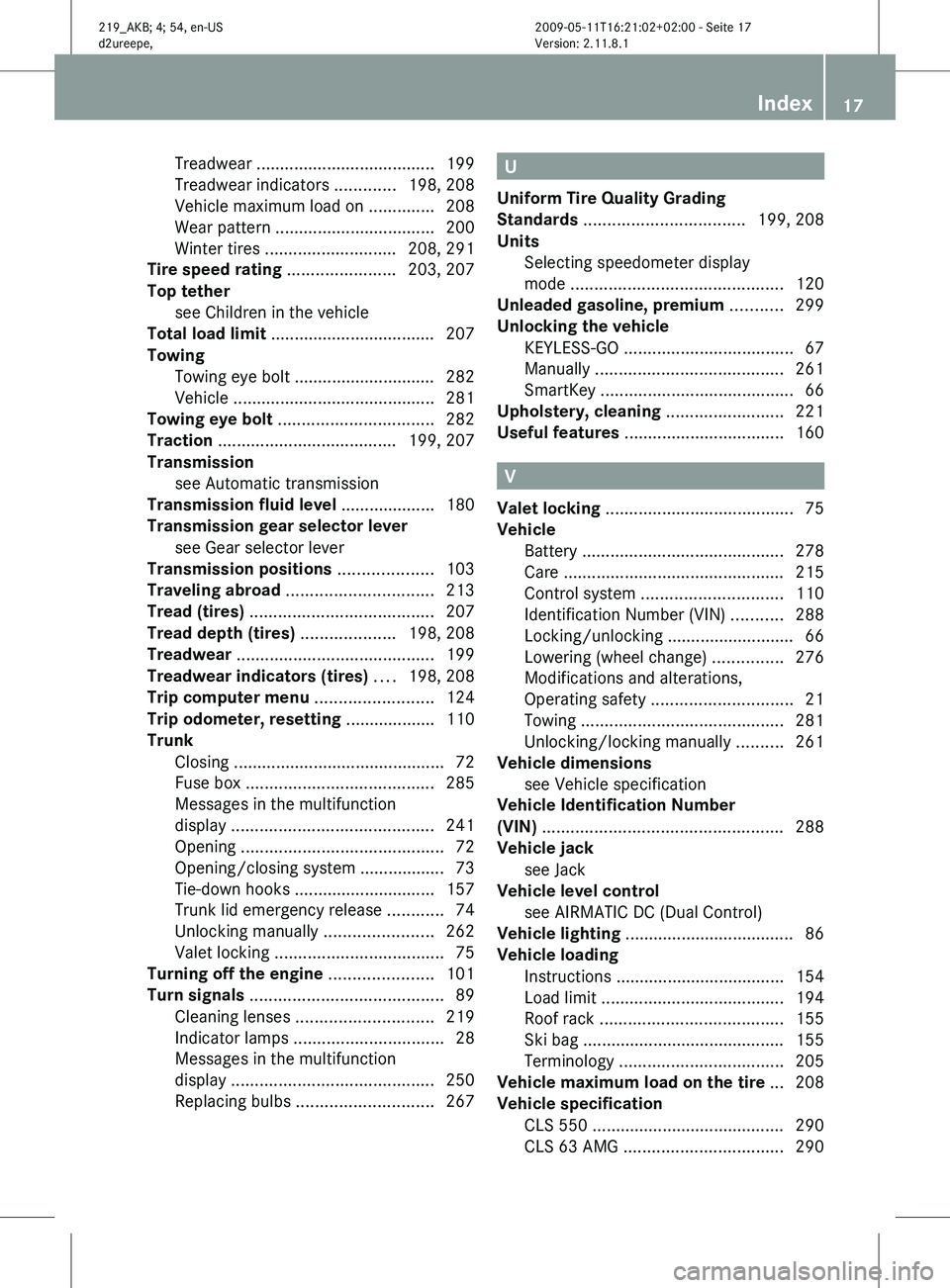
Treadwear
...................................... 199
Treadwear indicators .............198, 208
Vehicle maximum load on ..............208
Wear pattern .................................. 200
Winter tires ............................ 208, 291
Tire speed rating .......................203, 207
Top tether see Children in the vehicle
Total load limit ................................... 207
Towing
Towing eye bolt .............................. 282
Vehicle ........................................... 281
Towing eye bolt ................................. 282
Traction ...................................... 199, 207
Transmission see Automatic transmission
Transmission fluid level .................... 180
Transmission gear selector lever see Gear selector lever
Transmission positions ....................103
Traveling abroad ............................... 213
Tread (tires) ....................................... 207
Tread depth (tires) ....................198, 208
Treadwear .......................................... 199
Treadwear indicators (tires) .... 198, 208
Trip computer menu .........................124
Trip odometer, resetting ................... 110
Trunk
Closing ............................................. 72
Fuse box ........................................ 285
Messages in the multifunction
display ........................................... 241
Opening ........................................... 72
Opening/closing system .................. 73
Tie-down hooks .............................. 157
Trunk lid emergency release ............ 74
Unlocking manually .......................262
Valet locking .................................... 75
Turning off the engine ......................101
Turn signals ......................................... 89
Cleaning lenses ............................. 219
Indicator lamps ................................ 28
Messages in the multifunction
display ........................................... 250
Replacing bulbs ............................. 267 U
Uniform Tire Quality Grading
Standards .................................. 199, 208
Units Selecting speedometer display
mode ............................................. 120
Unleaded gasoline, premium ........... 299
Unlocking the vehicle
KEYLESS-GO
.................................... 67
Manually ........................................ 261
SmartKey ......................................... 66
Upholstery, cleaning .........................221
Useful features .................................. 160 V
Valet locking ........................................ 75
Vehicle
Battery ........................................... 278
Care ............................................... 215
Control system .............................. 110
Identification Number (VIN) ........... 288
Locking/unlocking
........................... 66
Lowering (wheel change) ...............276
Modifications and alterations,
Operating safety .............................. 21
Towing ........................................... 281
Unlocking/locking manually .......... 261
Vehicle dimensions
see Vehicle specification
Vehicle Identification Number
(VIN) ................................................... 288
Vehicle jack see Jack
Vehicle level control
see AIRMATIC DC (Dual Control)
Vehicle lighting .................................... 86
Vehicle loading
Instructions .................................... 154
Load limit ....................................... 194
Roof rack ....................................... 155
Ski bag ........................................... 155
Terminology ................................... 205
Vehicle maximum load on the tire ... 208
Vehicle specification
CLS 550 ......................................... 290
CLS 63 AMG .................................. 290 Index
17 219_AKB; 4; 54, en-US
d2ureepe,
Version: 2.11.8.1 2009-05-11T16:21:02+02:00 - Seite 17
Page 31 of 308
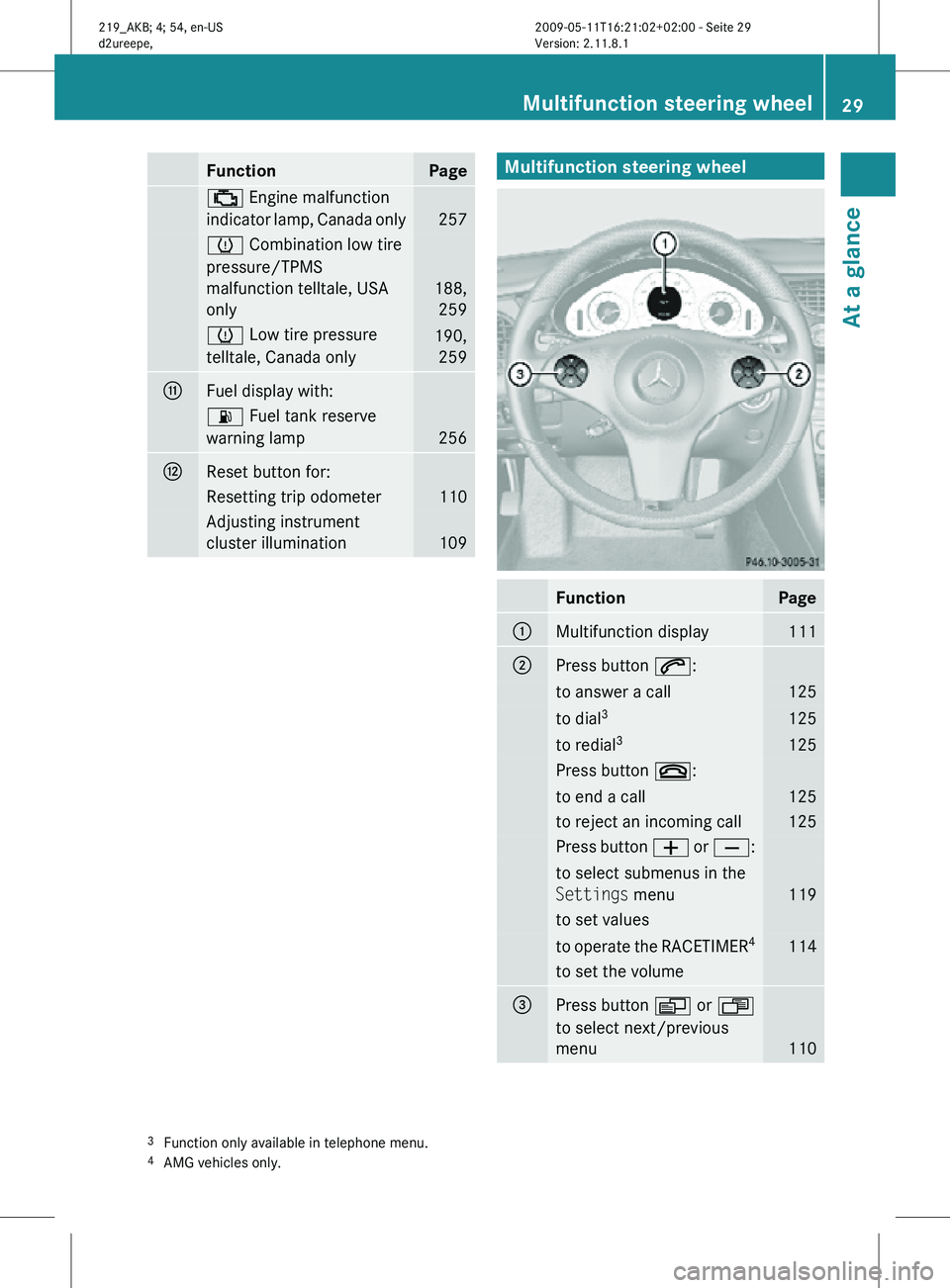
Function Page
; Engine malfunction
indicator lamp, Canada only
257
h Combination low tire
pressure/TPMS
malfunction telltale, USA
only
188,
259 h Low tire pressure
telltale, Canada only
190,
259 G
Fuel display with:
6 Fuel tank reserve
warning lamp
256
H
Reset button for:
Resetting trip odometer 110
Adjusting instrument
cluster illumination
109 Multifunction steering wheel
Function Page
:
Multifunction display 111
;
Press button 6:
to answer a call 125
to dial
3 125
to redial
3 125
Press button ~:
to end a call 125
to reject an incoming call 125
Press button
W or X: to select submenus in the
Settings menu
119
to set values
to operate the RACETIMER
4 114
to set the volume
=
Press button V or U
to select next/previous
menu 110
3
Function only available in telephone menu.
4 AMG vehicles only. Multifunction steering wheel
29At a glance
219_AKB; 4; 54, en-US
d2ureepe, Version: 2.11.8.1 2009-05-11T16:21:02+02:00 - Seite 29 Z
Page 42 of 308
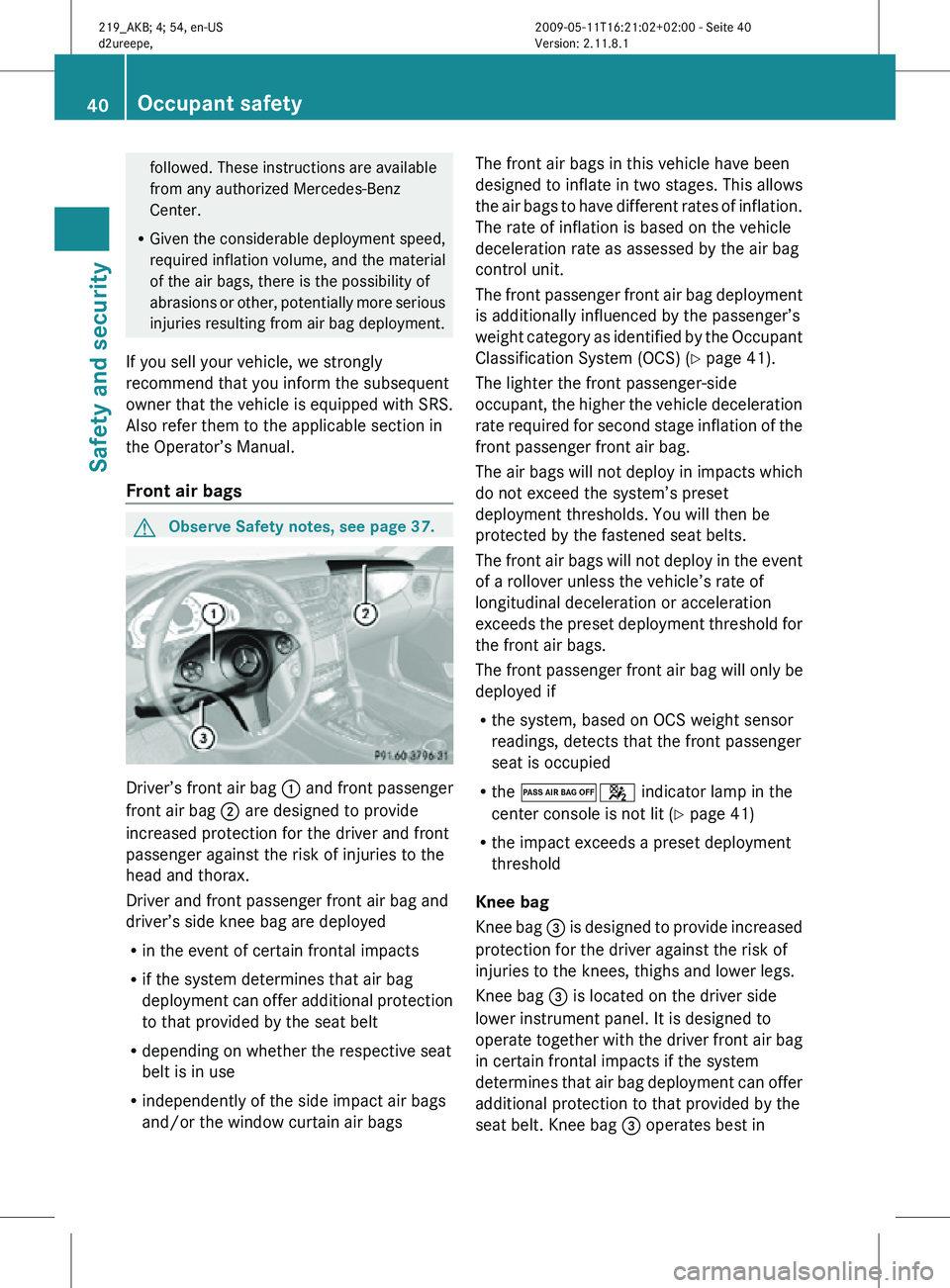
followed. These instructions are available
from any authorized Mercedes-Benz
Center.
R Given the considerable deployment speed,
required inflation volume, and the material
of the air bags, there is the possibility of
abrasions or other, potentially more serious
injuries resulting from air bag deployment.
If you sell your vehicle, we strongly
recommend that you inform the subsequent
owner that the vehicle is equipped with SRS.
Also refer them to the applicable section in
the Operator’s Manual.
Front air bags G
Observe Safety notes, see page 37. Driver’s front air bag
: and front passenger
front air bag ; are designed to provide
increased protection for the driver and front
passenger against the risk of injuries to the
head and thorax.
Driver and front passenger front air bag and
driver’s side knee bag are deployed
R in the event of certain frontal impacts
R if the system determines that air bag
deployment can offer additional protection
to that provided by the seat belt
R depending on whether the respective seat
belt is in use
R independently of the side impact air bags
and/or the window curtain air bags The front air bags in this vehicle have been
designed to inflate in two stages. This allows
the air bags to have different rates of inflation.
The rate of inflation is based on the vehicle
deceleration rate as assessed by the air bag
control unit.
The front passenger front air bag deployment
is additionally influenced by the passenger’s
weight category as identified by the Occupant
Classification System (OCS) (
Y page 41).
The lighter the front passenger-side
occupant, the higher the vehicle deceleration
rate required for second stage inflation of the
front passenger front air bag.
The air bags will not deploy in impacts which
do not exceed the system’s preset
deployment thresholds. You will then be
protected by the fastened seat belts.
The front air bags will not deploy in the event
of a rollover unless the vehicle’s rate of
longitudinal deceleration or acceleration
exceeds the preset deployment threshold for
the front air bags.
The front passenger front air bag will only be
deployed if
R the system, based on OCS weight sensor
readings, detects that the front passenger
seat is occupied
R the 04 indicator lamp in the
center console is not lit (Y page 41)
R the impact exceeds a preset deployment
threshold
Knee bag
Knee bag = is designed to provide increased
protection for the driver against the risk of
injuries to the knees, thighs and lower legs.
Knee bag = is located on the driver side
lower instrument panel. It is designed to
operate together with the driver front air bag
in certain frontal impacts if the system
determines that air bag deployment can offer
additional protection to that provided by the
seat belt. Knee bag = operates best in 40
Occupant safetySafety and security
219_AKB; 4; 54, en-US
d2ureepe,
Version: 2.11.8.1 2009-05-11T16:21:02+02:00 - Seite 40
Page 43 of 308
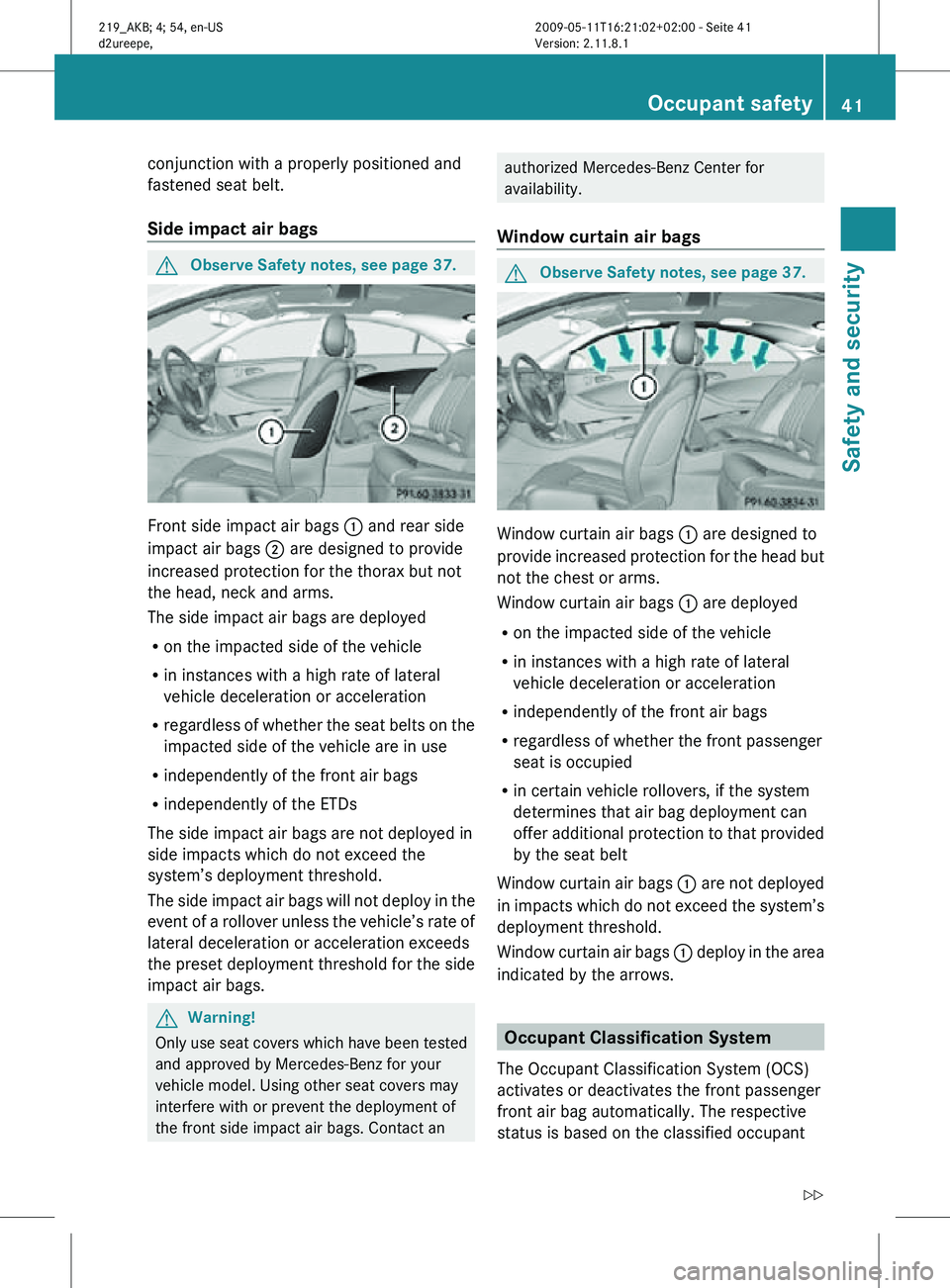
conjunction with a properly positioned and
fastened seat belt.
Side impact air bags
G
Observe Safety notes, see page 37. Front side impact air bags
: and rear side
impact air bags ; are designed to provide
increased protection for the thorax but not
the head, neck and arms.
The side impact air bags are deployed
R on the impacted side of the vehicle
R in instances with a high rate of lateral
vehicle deceleration or acceleration
R regardless of whether the seat belts on the
impacted side of the vehicle are in use
R independently of the front air bags
R independently of the ETDs
The side impact air bags are not deployed in
side impacts which do not exceed the
system’s deployment threshold.
The side impact air bags will not deploy in the
event of a rollover unless the vehicle’s rate of
lateral deceleration or acceleration exceeds
the preset deployment threshold for the side
impact air bags. G
Warning!
Only use seat covers which have been tested
and approved by Mercedes-Benz for your
vehicle model. Using other seat covers may
interfere with or prevent the deployment of
the front side impact air bags. Contact an authorized Mercedes-Benz Center for
availability.
Window curtain air bags G
Observe Safety notes, see page 37. Window curtain air bags
: are designed to
provide increased protection for the head but
not the chest or arms.
Window curtain air bags : are deployed
R on the impacted side of the vehicle
R in instances with a high rate of lateral
vehicle deceleration or acceleration
R independently of the front air bags
R regardless of whether the front passenger
seat is occupied
R in certain vehicle rollovers, if the system
determines that air bag deployment can
offer additional protection to that provided
by the seat belt
Window curtain air bags : are not deployed
in impacts which do not exceed the system’s
deployment threshold.
Window curtain air bags : deploy in the area
indicated by the arrows. Occupant Classification System
The Occupant Classification System (OCS)
activates or deactivates the front passenger
front air bag automatically. The respective
status is based on the classified occupant Occupant safety
41Safety and security
219_AKB; 4; 54, en-US
d2ureepe, Version: 2.11.8.1 2009-05-11T16:21:02+02:00 - Seite 41 Z
Page 45 of 308
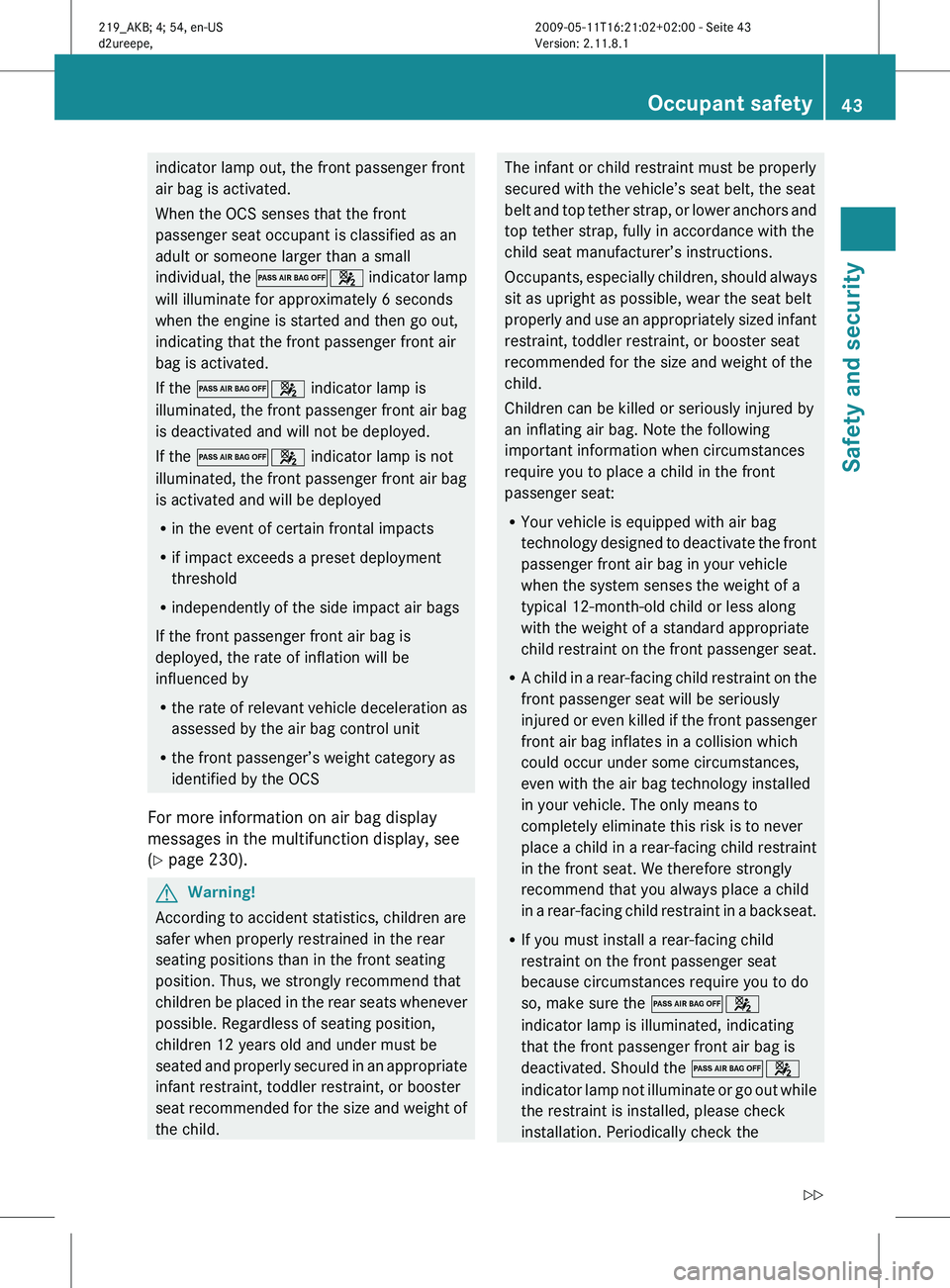
indicator lamp out, the front passenger front
air bag is activated.
When the OCS senses that the front
passenger seat occupant is classified as an
adult or someone larger than a small
individual,
the 04 indicator lamp
will illuminate for approximately 6 seconds
when the engine is started and then go out,
indicating that the front passenger front air
bag is activated.
If the 04 indicator lamp is
illuminated, the front passenger front air bag
is deactivated and will not be deployed.
If the 04 indicator lamp is not
illuminated, the front passenger front air bag
is activated and will be deployed
R in the event of certain frontal impacts
R if impact exceeds a preset deployment
threshold
R independently of the side impact air bags
If the front passenger front air bag is
deployed, the rate of inflation will be
influenced by
R the rate of relevant vehicle deceleration as
assessed by the air bag control unit
R the front passenger’s weight category as
identified by the OCS
For more information on air bag display
messages in the multifunction display, see
(Y page 230). G
Warning!
According to accident statistics, children are
safer when properly restrained in the rear
seating positions than in the front seating
position. Thus, we strongly recommend that
children
be placed in the rear seats whenever
possible. Regardless of seating position,
children 12 years old and under must be
seated and properly secured in an appropriate
infant restraint, toddler restraint, or booster
seat recommended for the size and weight of
the child. The infant or child restraint must be properly
secured with the vehicle’s seat belt, the seat
belt
and top tether strap, or lower anchors and
top tether strap, fully in accordance with the
child seat manufacturer’s instructions.
Occupants, especially children, should always
sit as upright as possible, wear the seat belt
properly and use an appropriately sized infant
restraint, toddler restraint, or booster seat
recommended for the size and weight of the
child.
Children can be killed or seriously injured by
an inflating air bag. Note the following
important information when circumstances
require you to place a child in the front
passenger seat:
R Your vehicle is equipped with air bag
technology designed to deactivate the front
passenger front air bag in your vehicle
when the system senses the weight of a
typical 12-month-old child or less along
with the weight of a standard appropriate
child restraint on the front passenger seat.
R A child in a rear-facing child restraint on the
front passenger seat will be seriously
injured or even killed if the front passenger
front air bag inflates in a collision which
could occur under some circumstances,
even with the air bag technology installed
in your vehicle. The only means to
completely eliminate this risk is to never
place a child in a rear-facing child restraint
in the front seat. We therefore strongly
recommend that you always place a child
in a rear-facing child restraint in a backseat.
R If you must install a rear-facing child
restraint on the front passenger seat
because circumstances require you to do
so, make sure the 04
indicator lamp is illuminated, indicating
that the front passenger front air bag is
deactivated. Should the 04
indicator lamp not illuminate or go out while
the restraint is installed, please check
installation. Periodically check the Occupant safety
43
Safety and security
219_AKB; 4; 54, en-US
d2ureepe, Version: 2.11.8.1 2009-05-11T16:21:02+02:00 - Seite 43 Z
Page 48 of 308
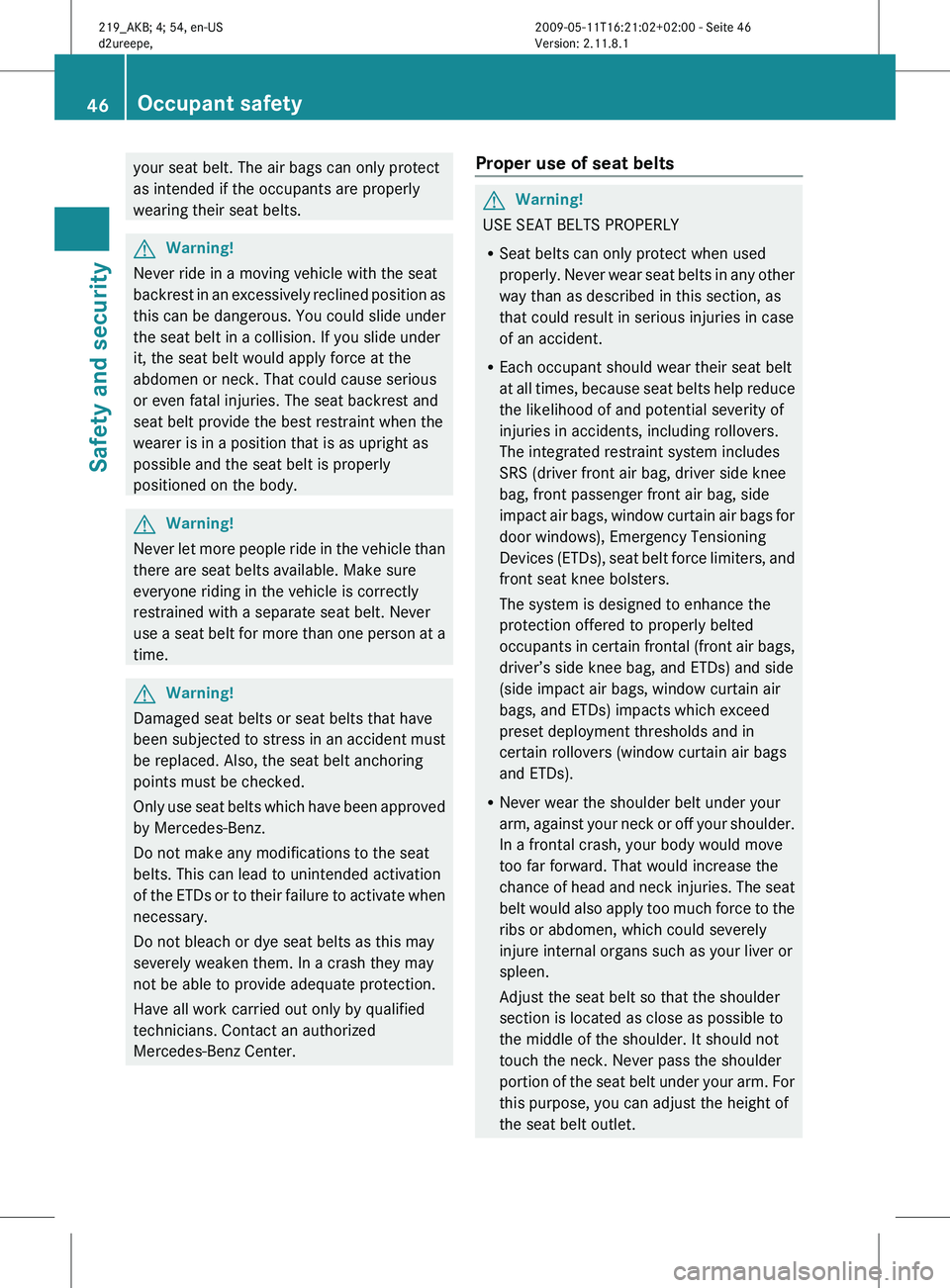
your seat belt. The air bags can only protect
as intended if the occupants are properly
wearing their seat belts.
G
Warning!
Never ride in a moving vehicle with the seat
backrest in an excessively reclined position as
this can be dangerous. You could slide under
the seat belt in a collision. If you slide under
it, the seat belt would apply force at the
abdomen or neck. That could cause serious
or even fatal injuries. The seat backrest and
seat belt provide the best restraint when the
wearer is in a position that is as upright as
possible and the seat belt is properly
positioned on the body. G
Warning!
Never let more people ride in the vehicle than
there are seat belts available. Make sure
everyone riding in the vehicle is correctly
restrained with a separate seat belt. Never
use
a seat belt for more than one person at a
time. G
Warning!
Damaged seat belts or seat belts that have
been
subjected to stress in an accident must
be replaced. Also, the seat belt anchoring
points must be checked.
Only use seat belts which have been approved
by Mercedes-Benz.
Do not make any modifications to the seat
belts. This can lead to unintended activation
of the ETDs or to their failure to activate when
necessary.
Do not bleach or dye seat belts as this may
severely weaken them. In a crash they may
not be able to provide adequate protection.
Have all work carried out only by qualified
technicians. Contact an authorized
Mercedes-Benz Center. Proper use of seat belts G
Warning!
USE SEAT BELTS PROPERLY
R Seat belts can only protect when used
properly.
Never wear seat belts in any other
way than as described in this section, as
that could result in serious injuries in case
of an accident.
R Each occupant should wear their seat belt
at all times, because seat belts help reduce
the likelihood of and potential severity of
injuries in accidents, including rollovers.
The integrated restraint system includes
SRS (driver front air bag, driver side knee
bag, front passenger front air bag, side
impact air bags, window curtain air bags for
door windows), Emergency Tensioning
Devices (ETDs), seat belt force limiters, and
front seat knee bolsters.
The system is designed to enhance the
protection offered to properly belted
occupants in certain frontal (front air bags,
driver’s side knee bag, and ETDs) and side
(side impact air bags, window curtain air
bags, and ETDs) impacts which exceed
preset deployment thresholds and in
certain rollovers (window curtain air bags
and ETDs).
R Never wear the shoulder belt under your
arm, against your neck or off your shoulder.
In a frontal crash, your body would move
too far forward. That would increase the
chance of head and neck injuries. The seat
belt would also apply too much force to the
ribs or abdomen, which could severely
injure internal organs such as your liver or
spleen.
Adjust the seat belt so that the shoulder
section is located as close as possible to
the middle of the shoulder. It should not
touch the neck. Never pass the shoulder
portion of the seat belt under your arm. For
this purpose, you can adjust the height of
the seat belt outlet. 46
Occupant safety
Safety and security
219_AKB; 4; 54, en-US
d2ureepe,
Version: 2.11.8.1 2009-05-11T16:21:02+02:00 - Seite 46
Page 51 of 308
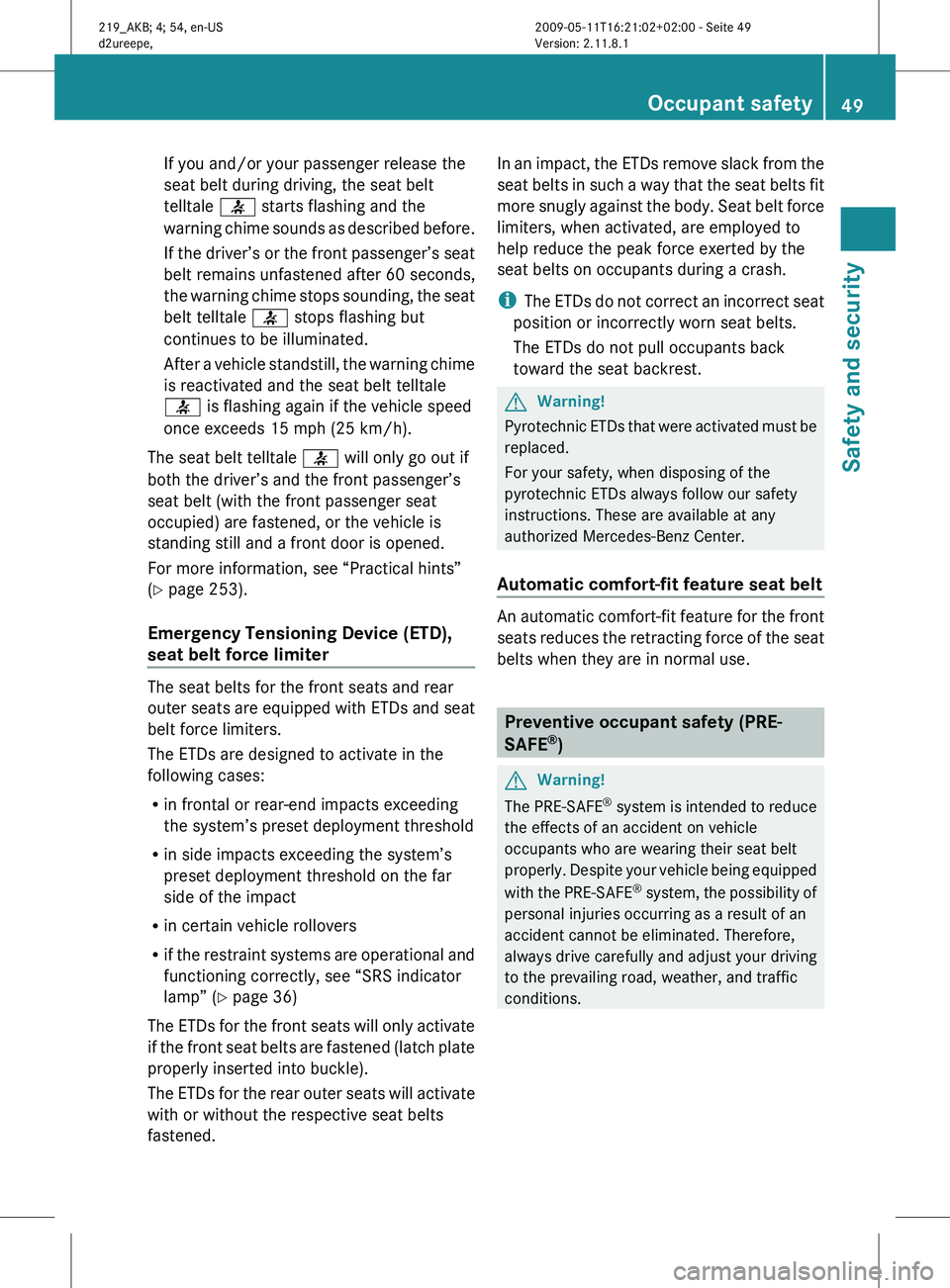
If you and/or your passenger release the
seat belt during driving, the seat belt
telltale
7 starts flashing and the
warning
chime sounds as described before.
If the driver’s or the front passenger’s seat
belt remains unfastened after 60 seconds,
the warning chime stops sounding, the seat
belt telltale 7 stops flashing but
continues to be illuminated.
After a vehicle standstill, the warning chime
is reactivated and the seat belt telltale
7 is flashing again if the vehicle speed
once exceeds 15 mph (25 km/h).
The seat belt telltale 7 will only go out if
both the driver’s and the front passenger’s
seat belt (with the front passenger seat
occupied) are fastened, or the vehicle is
standing still and a front door is opened.
For more information, see “Practical hints”
(Y page 253).
Emergency Tensioning Device (ETD),
seat belt force limiter The seat belts for the front seats and rear
outer
seats are equipped with ETDs and seat
belt force limiters.
The ETDs are designed to activate in the
following cases:
R in frontal or rear-end impacts exceeding
the system’s preset deployment threshold
R in side impacts exceeding the system’s
preset deployment threshold on the far
side of the impact
R in certain vehicle rollovers
R if the restraint systems are operational and
functioning correctly, see “SRS indicator
lamp” (Y page 36)
The ETDs for the front seats will only activate
if the front seat belts are fastened (latch plate
properly inserted into buckle).
The ETDs for the rear outer seats will activate
with or without the respective seat belts
fastened. In an impact, the ETDs remove slack from the
seat
belts in such a way that the seat belts fit
more snugly against the body. Seat belt force
limiters, when activated, are employed to
help reduce the peak force exerted by the
seat belts on occupants during a crash.
i The ETDs do not correct an incorrect seat
position or incorrectly worn seat belts.
The ETDs do not pull occupants back
toward the seat backrest. G
Warning!
Pyrotechnic ETDs that were activated must be
replaced.
For your safety, when disposing of the
pyrotechnic ETDs always follow our safety
instructions. These are available at any
authorized Mercedes-Benz Center.
Automatic comfort-fit feature seat belt An automatic comfort-fit feature for the front
seats
reduces the retracting force of the seat
belts when they are in normal use. Preventive occupant safety (PRE-
SAFE
®
) G
Warning!
The PRE-SAFE ®
system is intended to reduce
the effects of an accident on vehicle
occupants who are wearing their seat belt
properly. Despite your vehicle being equipped
with the PRE-SAFE ®
system, the possibility of
personal injuries occurring as a result of an
accident cannot be eliminated. Therefore,
always drive carefully and adjust your driving
to the prevailing road, weather, and traffic
conditions. Occupant safety
49
Safety and security
219_AKB; 4; 54, en-US
d2ureepe, Version: 2.11.8.1 2009-05-11T16:21:02+02:00 - Seite 49 Z